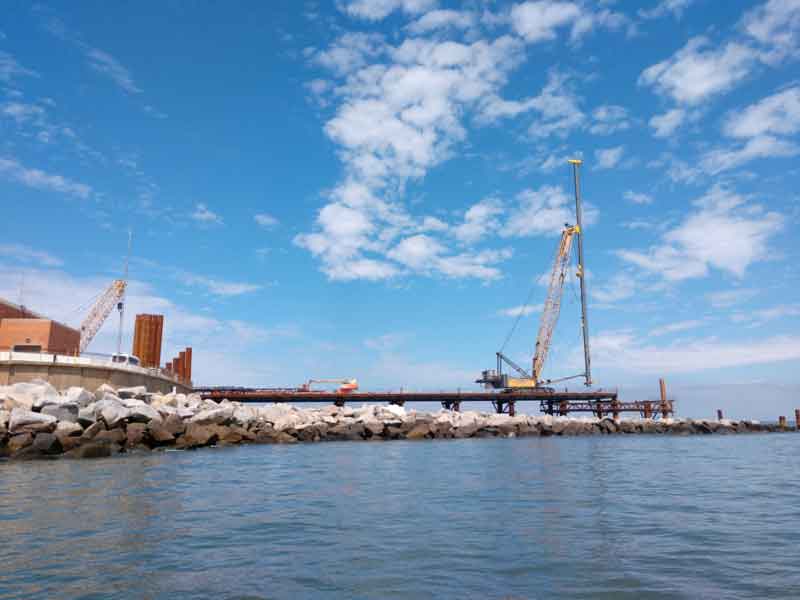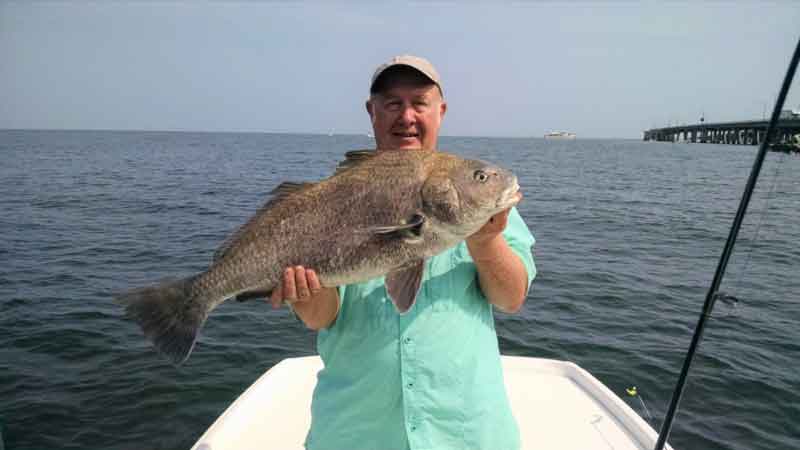I suppose it is safe to say I “grew up” fishing the Chesapeake Bay Bridge-Tunnel (CBBT). I’ve been known to brag that I know every piling of the 17.6-mile crossing. And in reality, I have fished just about every bit of this structure over the years. The original bridge tunnel was completed in 1964, when I was about 10 years old. The CBBT was named “One of the Seven Engineering Wonders of the Modern World.” It replaced a ferry service from Norfolk to the Eastern Shore and cut off approximately 95 miles of travel by land from Norfolk/Virginia Beach to Delaware and north.

The parallel bridge was completed in 1999, with a promise that parallel tunnels would be added soon. This brought the above-water roadway to four lanes (two northbound lanes on the original bridge, and two southbound lanes on the new bridge). The new bridge was connected to the four islands (we count them from south to north – the “first island” being the southernmost). Speaking of the first island, it included a gift shop and restaurant which was closed with the construction of the new tunnel. It also has a fishing pier which is supposed to be renovated and reopened after the current project is complete.
Construction is now underway for the tunnel under the Thimble Shoal Channel between the first and second islands. The other new tunnel under the Baltimore Channel, between the third and fourth islands, is supposed to follow.
CBBT Construction Process
All the other tunnels in southeast Virginia (10 in total between the existing CBBT tubes, Hampton Roads, Monitor/Merrimac, Mid-Town, and Downtown tunnels) used the “trenching” method. In this method, a trench is dug along the bottom, sections of the tunnel are dropped into the trench and attached. This is referred to as “immersed tube tunnel alignment.” Once in place, fill soil is added around the tube and it is covered with boulders. These tubes add a lot of structure to the bottom, and we all know that structure attracts fish like drum, stripers, flounder, tautog, and more.
The new tunnel, however, will use different technology known as “boring.” A huge machine dubbed “Chessie” (named by a contest of sixth graders) bores a hole under the bottom of the channel, building the tunnel behind it in pieces. Each circular section of the tube will be composed of several pieces which are built above ground and taken inside the growing tube by rail car. Each section is grouted and bolted into place by the boring machine. At its deepest, the top of the tunnel will be about 105 feet below the water’s surface. Given that the channel is 55 or 60 feet deep, the tunnel will be a good distance below the bottom.
Boring is widely used in Europe and Asia. One advantage is less environmental impact on the Bay. But one drawback is that “additives” are blasted into the soil to keep the cutting head of the boring machine lubricated and make the soil flow through pipes back to the surface. This makes the soil unfit for dumping offshore (as has been done with the trench style tunnels in the area). The spoils must be disposed of on land in special landfills.
Fishing Impacts of Tunnel Construction
As far as I can tell thus far, most of the work happens out of sight and causes little impact on fishing. There have been temporary docks built and placed to offload the tunnel tube sections. Long ago they dumped a lot of new boulders on the tube end of the first island. Conveyor belts have been built to transport the soill bored up from below. More than 9000 tunnel segments are built and ready to install. Boring began in February of 2023 but was soon suspended when the boring machine hit what was believed to be a huge old anchor and the machine sustained significant damage. It restarted this April and has already completed more than 600 feet of tunneling, but the incident added 241 days to the timetable.
The currently forecast completion is late summer of 2027. At this point we just don’t yet know how the finished project will affect fishing in the area. This takes on added importance since there’s also a project to double the size of the Hampton Roads Bridge-Tunnel in the coming years. Survey work has begun on that project.

As for right now, fishing possibilities around the first and second islands remain good. Around the islands you may find everything including bluefish, Spanish mackerel, trout, flounder, redfish, black drum - the list goes on and on. From May through the summer and fall, there is always something biting here.
- Spadefish and triggerfish will bite pieces of clam on small hooks along the sides of the islands. The spades are usually five to 10 feet deep, and the triggers are anywhere from five feet down to the bottom. Anchor up, drop your baits over, and put the rods in the holders. Do not pick up the rod until it stays bent over.
- Sheepshead may be found around the pilings near the islands anywhere from just under the surface to the bottom. They will bite clams or small fiddler crabs. Drop the bait along the side of the piling.
- Tautog love structure. Fish for them on the bottom in 10 to 15 feet of water over the rocks covering the tubes near the islands. They like crabs; most people use fiddler crabs or cut pieces of blue crab. Anchor up using a wreck anchor snagged in the rocks.
- Flounder and trout (specks and greys) may be found along the sides of the islands, and along pilings near the islands. In the past few years grey trout have not been around and flounder have played hard to get. But my two personal best flounder were both caught near the first island. Last fall we had a good run of nice size specks at both the first and second islands in early fall.
- Bluefish are almost always present in the summer. They may be caught jigging the sides of the islands or trolling small spoons behind in-line sinkers or planers near the islands. Spanish mackerel will also be caught trolling the area. Last year we had the best year for large Spanish in recent memory.
- Red and black drum typically stay around here into the early fall. I have caught all sizes of both species along the sides of the islands. I typically use lead head jigs for these fish, but reds also love a live croaker or spot fished on the bottom.
- Striper fishing comes and goes in this area. There have been times you couldn’t find a single fish, and other times when they were abundant. The past few years haven’t been the best of times at the CBBT for them.
Now, back to the question: How will the tunnel project affect fishing? So far, I can’t blame the project for much of anything. The Bay side of the first island has been most affected. But that has always been my least favorite place to fish this area. It seems like fishing on the ocean side of the first island has not been as good as some years but I don’t know if that has to do with the work, or just the fickle nature of fishing.
The second island hasn’t been largely impacted. I caught a personal best 48-inch red drum there last summer (cheered on by a group of construction workers on lunch break up on the island). I hope my favorite fishing holes there will remain unchanged, but that’s not likely. One thing for sure: the project will add a lot of new boulders into the water, and in my way of thinking, this can only be a good thing for fishing. Since the new tubes will be well below the bottom as it crosses the channel, I just can’t see a lot of future impact there.
The Chesapeake Bay Bridge-Tunnel website has a lot of information on the project. I wish they would keep it updated better regarding the progress of the work, but other than that, it is thorough.
The Rogue Rock
Anyone who has ever fished off the end of the third island knows there is a barely submerged rock — the Rogue Rock — way past where it ought to be. This rock has ruined its share of lower units over the years. Legend has it that a section of the tunnel pipe slipped as it was being submerged into place, and they had to add extra stones on top of it. If you fish that area, watch out for this unmarked hazard.
-By Chuck Harrison
Editor's note: This article was originally published in August of 2020 and was last updated for accuracy in May of 2024.